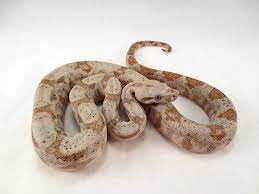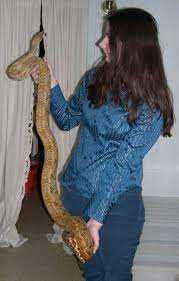One of the main factors that make Hog Island Boas so appealing to reptile enthusiasts is their size. Unlike other species of boa constrictors, Hog Island Boas stay relatively small, making them easier to handle and care for. Adult Hog Island Boas typically reach a length of about 4 to 6 feet, with females being slightly larger than males.
Another interesting aspect of Hog Island Boa size is their growth rate. These boas tend to grow at a slower pace compared to other boa constrictor subspecies. While it can vary depending on factors such as diet and enclosure conditions, it generally takes Hog Island Boas several years to reach their full adult size.
Hog Island Boa Size
Growth and Development
Hog island boas undergo a process of growth and development throughout their lives. As hatchlings, they are approximately 12-14 inches long and weigh around 30-40 grams. Over the course of several years, they gradually increase in size and weight, reaching their full adult size.
Factors such as diet, environment, and genetics can influence the growth and development of hog island boas. A well-balanced diet consisting of appropriately sized prey items, a suitable enclosure with adequate space and temperature, and good genetics are essential for the proper growth and development of these snakes.
Measuring Hog Island Boa Size
Measuring hog island boas is important for documenting their growth and monitoring their overall health. There are several methods and tools available for measuring the size of these snakes. One common method is using a flexible measuring tape to measure the length from the tip of the snout to the end of the tail.
In addition to length, the weight of a hog island boa can also be measured using a scale specifically designed for reptiles. This provides valuable information about the overall condition and well-being of the snake.
| Size Category | Length (in feet) |
|---|---|
| Juvenile | |
| Sub-Adult | |
| Adult |
Monitoring the size of hog island boas allows breeders, researchers, and owners to track the growth and development of these snakes. It also helps in identifying any issues such as stunted growth or obesity, which can be addressed through appropriate care and adjustments in their diet and environment.
Factors affecting the size of Hog Island Boas include genetics, diet, and environmental conditions. Genetic factors play a significant role, as certain bloodlines may have different growth patterns and sizes compared to others. Diet also plays a crucial role in determining the size of the snake, as a well-balanced and nutritious diet can promote healthy growth. Proper temperature and humidity levels in the snake’s enclosure are also important, as suboptimal conditions can hinder growth.
Factors Affecting Hog Island Boa Size
One of the primary factors that affect the size of a hog island boa is genetics. Just like humans, boa constrictors have different genetic codes that determine their growth potential. Some boas may naturally grow larger than others due to their genetic makeup.
Environmental factors also play a role in determining the size of a hog island boa. The temperature and humidity levels in their habitat can affect their metabolism and overall growth. It is essential to provide the proper environmental conditions for these reptiles to ensure optimal growth and development.
Lastly, the availability of space can affect the size of a hog island boa. These snakes require a spacious enclosure to allow for movement and exercise. Limited space can restrict their growth potential and may result in stunted growth.
Hog Island Boa Size: Influences on Growth and Development
Influencing Factors
Several factors can influence the growth and development of Hog Island boas. These factors include genetics, nutrition, environment, and overall health. Genetics play a significant role in determining the maximum size a boa can reach. Some individuals may have genetic predispositions to grow larger or smaller than average.
Nutrition also plays a crucial role in the growth and development of Hog Island boas. A well-balanced diet consisting of appropriately sized prey items is necessary to ensure proper growth. Feeding frequency and portion size should be carefully monitored to prevent obesity or malnourishment.
The environment in which a Hog Island boa is kept can also affect its growth. Providing a spacious enclosure with suitable temperatures and humidity levels is vital. A properly maintained habitat allows the snake to thrive and reach its full growth potential.
Additionally, the overall health of the snake can impact its growth. Regular veterinary check-ups, proper hygiene, and disease prevention measures are necessary to maintain optimal health. Illnesses or parasites can negatively affect a snake’s growth and development.
Measuring Hog Island Boa Size
Measuring the size of Hog Island boas is important for monitoring their growth and ensuring they are developing properly. Several methods and tools can be used for measurement. The most common method is measuring the snake’s length from the tip of its snout to the end of its tail.
Using a flexible tape measure, carefully place it along the snake’s body, following the contours. Take care not to stretch or compress the snake while measuring. Accurately recording the measurements can help track growth progress over time.
It is also essential to observe the snake’s body condition and muscle tone. A healthy boa should have a robust body, not overly thin or obese. Regularly monitoring weight and body condition can provide valuable insights into the snake’s overall health.
Measuring Hog Island Boa Size: A Guide for Reptile Enthusiasts
As a proud owner of a Hog Island Boa, it is essential to monitor its growth and development to ensure its overall health and well-being. Measuring your hog island boa’s size is a crucial aspect of this monitoring process, allowing you to track its growth and detect any potential health issues.
Why Measure Hog Island Boa Size?

Measuring the size of your hog island boa provides valuable insights into its growth and development. By regularly measuring its length, you can assess its overall health, track growth patterns, and identify any abnormalities. This information is vital not only for reptile enthusiasts but also for veterinarians and breeders, who rely on accurate size measurements to provide proper care and breeding guidance.
Methods for Measuring Hog Island Boa Size
There are several methods you can use to measure your hog island boa’s size. The most common and straightforward method is using a flexible measuring tape. Gently hold your snake in a straight line and extend the tape from the tip of its nose to the end of its tail, without forcing it to stretch. Take note of the measurement in inches or centimeters, depending on your preference.
Another method involves using a snake length ruler or a snake measuring board. These tools provide a rigid surface with clearly marked length indicators. Place your hog island boa on the ruler or board, aligning its nose with the zero mark and extending its tail along the ruler. Read the measurement at the end of its tail to obtain its size.
Tips for Accurate Measurement

When measuring your hog island boa’s size, it is essential to follow these guidelines for accuracy:
- Handle with care: Approach your snake calmly and gently to reduce stress during the measuring process.
- Avoid stretching: Allow your hog island boa to remain in a natural, relaxed posture without forcefully extending its body.
- Measure from the nose to the tail: Starting at the tip of its nose, measure along the contours of its body until the end of its tail.
- Record the measurements: Keep a journal or digital record of your hog island boa’s size measurements, including the date and the method used. This will help you track its growth over time.
Remember, measuring your hog island boa’s size is not only a necessary task but also an opportunity to bond with your pet. By handling your snake gently and maintaining a calm environment during the process, you can ensure a positive experience for both you and your beloved reptile companion.
Methods and Tools for Measurement
One common method for measuring the size of a Hog Island Boa is to use a measuring tape. This can be done by gently laying the snake out on a flat surface and extending the tape from the tip of the nose to the end of the tail. Care must be taken to ensure that the snake remains still during this process to prevent any injuries.
Another method for measuring Hog Island Boa size is through the use of calipers. Calipers are used to measure the diameter of the snake’s body at various points. This can provide valuable information about the snake’s overall health and growth rate.
Additional Tools
In addition to these traditional measurement methods, there are also more advanced tools available for measuring Hog Island Boa size. One such tool is a laser measuring system. This device uses laser technology to accurately measure the length of the snake without physically touching it. This can be especially useful for larger snakes or for those who may be more nervous around humans.
Another tool that can be used for measuring Hog Island Boa size is a digital scale. This allows owners to track the weight of their snake over time and make adjustments to their feeding regimen if necessary. This can be especially important for ensuring that the snake is growing at a healthy rate.
Tips for Accurate Measurement
- Ensure that the snake is completely stretched out and relaxed before attempting to measure its size.
- Take multiple measurements to ensure accuracy, especially if using a flexible tape measure.
- Be gentle when handling the snake and avoid putting excessive pressure on its body.
By utilizing these methods and tools for measurement, owners can effectively track the growth and development of their Hog Island Boas. This information is crucial for ensuring that these reptiles are healthy and well-cared for as pets.

I’m Lena Adams—a product of an unconventional upbringing in the African wilderness. My father, a daring explorer of African wildlife, sparked my fascination with reptiles, a passion that intertwined with the tragic loss of my mother during an expedition, leaving an indelible mark on my life. Driven to understand the creatures that captivated my parents, I embarked on my journey, sharing insights about reptiles, frogs, and lizards on my website. Through my explorations and conservation efforts, I honour my family’s legacy while seeking connections—to the creatures, nature, and the mother whose presence I yearn to understand.
